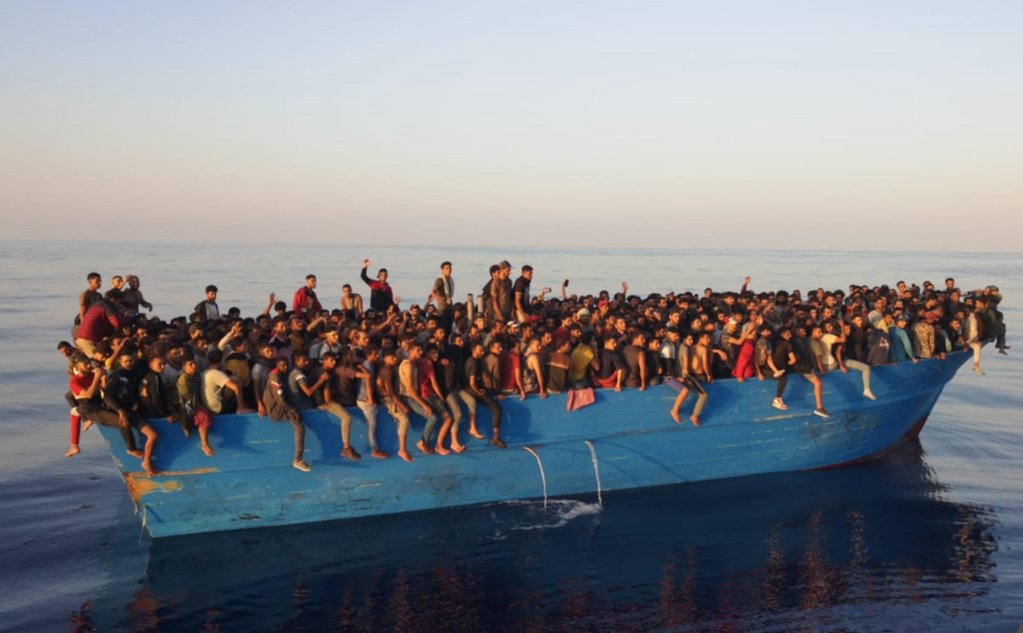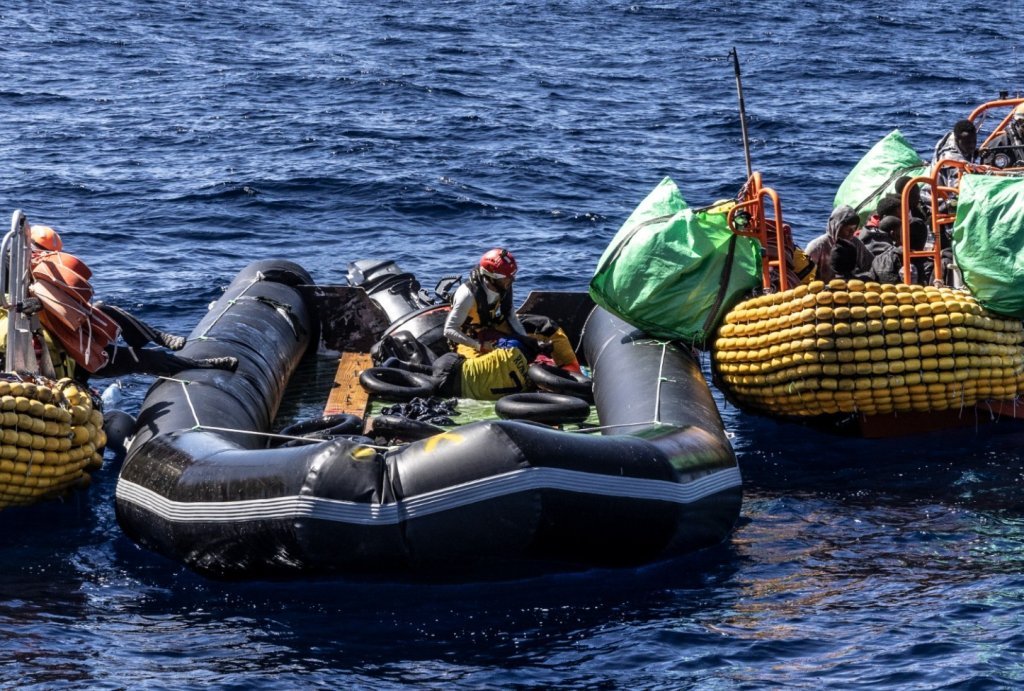Smugglers frequently deceive migrants, claiming that the journey across the Mediterranean is much safer than it is. That's why InfoMigrants is debunking the most common lies told to migrants hoping to cross from north Africa to Europe. This is part 2 of our series.
Over 25,000 migrants, including women and children, have drowned since 2014 while crossing the Mediterranean Sea. The overwhelming majority of these victims sought the services of a smuggler to attempt the crossing and reach European coasts. Each of them likely hoped for the boat to be solid enough, for the motor to be powerful enough and for the “guarantees” offered by the smugglers to be true.
Yet smugglers “lie about all their services”, according to the non-governmental organization SOS Méditerranée. The humanitarian organization regularly comes to the rescue of migrants in distress, in turn becoming a principal witness of their plight at sea.
InfoMigrants has drawn up a list of the lies propagated by human traffickers operating in the Mediterranean Sea. This is part 2 of our series. You can find the first part of our series here.
6.) Smugglers almost always overload the boats
Smugglers usually promise migrants safe crossings with a limited number of passengers on board. Yet InfoMigrants has collected numerous accounts of boats being suddenly overloaded with passengers just before the boat left.
Banfa, a Guinean we met in Lampedusa, said the smugglers had promised him there wouldn’t be more than 30 or 40 people in the iron vessel. "Yet at the last minute, the smugglers allowed more people on board, while they were still on the beach. There were too many of us. They confiscated bottles of water to reduce the weight of the vessel."
"The boats are always overcrowded," said Lucille Guenier, communications coordinator of SOS Méditerranée. "People usually don't have anywhere to sit; they have one foot in the water and one foot inside the boat. It's extremely dangerous, the slightest movement can destabilize the boat, and cause it to capsize."

Guenier has heard other kinds of lies told at the moment of boarding through the accounts of the migrants she met. Certain traffickers tell passengers there will be cabins on board, and that they can bring their suitcases. The migrants realize they've been tricked only once they arrive on the beach. "They want to turn around but they can't. They are forced to abandon their belongings and board. Many told me they were even forced at gunpoint to get inside boats."
7.) Most boats have weak motors
SOS Méditerranée often rescues migrants in boats with broken engines. "It happens very often -- either the migrants run out of gas or the engine breaks down," said Guenier.
Banfa, the migrant we met in Lampedusa, said that his smugglers lied about the quality of the boat’s engine. "They told me the boat’s motor was equipped with a 40hp engine, but it was actually a 30hp engine." The difference can make a real impact. Boats often struggle to navigate when they are overcrowded and have a weak engine. They also break down faster.
Two children, aged 3 and 4 years old, died of thirst in May 2025 on a boat adrift in the Mediterranean. The makeshift boat left Libya three days earlier, but the engine of the frail boat gave way during the trip, according to survivors.
Several migrants also told InfoMigrants that people from Tunisian coasts sometimes follow the boats and steal the engine at sea before bringing it back to shore. The engine-less boats then end up drifting, and the mortality rate is very high.
Read AlsoTunisian fishing crew charged with piracy for stealing migrant boat motor
Sometimes the authorities even participate in this theft of engines. Kalilou, a 28-year-old Ivorian, told InfoMigrants the Tunisian coast guard had stolen his boat's engine. "When they arrived [near the boat at sea], they took the gas cylinders and asked the captain to remove the engine. Then they left, letting the boat drift," said the migrant in 2023, after attempting the Mediterranean crossing several times.
8.) Smugglers refuse to give people life jackets -- or sell them fake ones
Equipping oneself with a life jacket increases the price of the crossing. "The migrants rescued by the Ocean Viking were not wearing life jackets in the vast majority of cases," said Guenier. "The ones you see in press photos were usually provided to migrants by our NGO during the rescue."
Read Also'We are there to act': Aboard a French ship rescuing migrants in the English Channel
Purchasing a life jacket in Libya is expensive. They can be bought before the crossing as part of the package negotiated with the smuggler or purchased individually. In both cases, "it's an expensive 'extra' that many can't afford," said Maurice Stierl, one of the founders of Alarm Phone.
"The migrants on the beach who ask for life jackets are often beaten by the smugglers," said Sissoko, a Malian who survived a shipwreck in 2016. "I remember on the day of departure, an Ivorian next to me saw a slight hole in his boat, with water flowing inside. He asked for a life jacket and said he wouldn't leave without it. The Libyans made him get off the boat and later beat him up."
"A [fluorescent orange] life jacket isn't discreet. It can attract the Libyan navy," according to a smuggler based in Tripoli, whose words were repeated to us by a migrant. Moreover, "wearing a life jacket takes up space. And we must fill the boats as much as possible," the trafficker reportedly said.
Obtaining a life jacket from traffickers is often synonymous with getting scammed. "The few life jackets I saw during my rescue missions didn't meet safety standards; they also didn't provide adequate buoyancy," said Guenier. "A life jacket isn't a guarantee of survival. Faced with rough seas, high waves, or wind, it doesn't prevent drowning."
The inner tubes from cars (or bicycle tires) often found around the bodies of migrants – most frequently sub-Saharan Africans – are no more effective. "You can protect yourself for a few seconds, but that kind of protection has never saved anyone from drowning at sea."

9.) Smugglers make false claims about the weather
Smugglers often promise departures in calm seas and clear weather. This is a flimsy assurance in the face of the volatile weather conditions at sea. "A boat can leave when the sea is calm and encounter a storm two hours later," said the communications coordinator of SOS Méditerranée. "Departures are more numerous in summer, but nothing guarantees a peaceful crossing. We have already carried out rescues in two-meter-high waves."
A boat sank in December 2024 after running into a storm off the Tunisian coast. Only an 11-year-old girl survived.
All the occupants of the vessel were swept away by the waves, according to her account. "Forty-four people drowned," stated Compass Collective, an NGO involved in migrant rescue missions in the Mediterranean. The child told rescuers that the metal boat had left Sfax, Tunisia. It later sank in a storm, "with 3.4-meter-high waves and 23-knot winds," according to the NGO.
If you want to read part one of this series, you can find it here.
